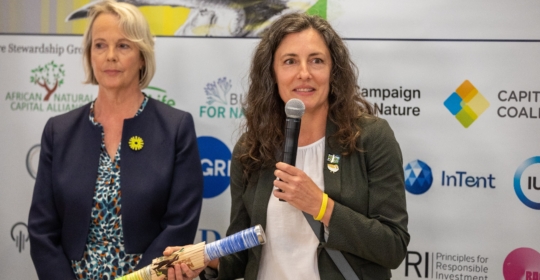
Integrating Nature and Climate Action: Reflections from Climate Week NYC
Post by Erin Billman, Executive Director, Science Based Targets Network
Last week, my colleagues from the Science Based Targets Network (SBTN) and I joined leaders in business, government, science and civil society from across the world in New York for Climate Week NYC. This annual summit is focused on driving climate action ahead of the UN General Assembly and COP28.
Nature’s importance continues to rise up the agenda at climate-focused events. Notable manifestations of this at Climate Week NYC included the Nature Positive Hub hosted by Nature4Climate and a reception for the recently-launched Nature Positive initiative, which includes SBTN and Global Commons Alliance along with 25 of the world’s largest nature conservation groups.
However nature still remains relatively siloed. We know there is no path to net zero without nature. We know limiting global warming and halting and reversing nature loss are mutually supporting goals. And we know human health is dependent on both, and last week showed encouraging developments on that front with events connecting climate change to human health and mobility. Nature must be fully integrated into climate action and vice versa, with social justice as a foundational principle.
That’s where the systems shifting power of business comes in. With last week’s launch of Taskforce on Nature-related Financial Disclosures (TNFD) final Recommendations for nature-related risk management and disclosure, SBTN and TNFD co-hosted an event to highlight our distinct and complementary roles in helping companies contribute to nature positive outcomes – akin to SBTi and TCFD’s efforts for climate – with fresh insights shared from some of the companies that are piloting both frameworks.
We also highlighted our co-authored paper on target-setting, part of TNFD’s launch. Our collective goal is to have as integrated an approach as possible for companies looking to both disclose their nature-related risks and take action enabled by setting science-based targets for nature.
Complementary yet distinct frameworks
Spotlighting the complementary risk and disclosure framework and rigorous target-setting methodology of the two frameworks, Emily McKenzie, Technical Director, TNFD, said: “We have recommended that corporates when they are setting targets for nature, apply SBTN’s method – because in the philosophy of TNFD, we are going to consolidate and bring together the best of what already exists.”
TNFD will keep updating the framework to remain “nimble and agile, and signposting to the latest of what SBTN has done”, as elaborated by Emily.
Diane Holdorf, Managing Director of Food & Nature at the World Business Council for Sustainable Development (WBCSD) – who was moderating the conversation between Emily and myself – provided a glimpse into our partnership with TNFD. She highlighted our close collaboration by pointing out how we “can answer for each other, because they know deeply how each system component works.”
Future plans
I also let attendees know about SBTN’s plans to release finance sector guidance – a pre-step to finance sector targets. This will focus on how the finance sector can meaningfully engage with our corporate target setting methods to mobilize action. We are looking forward to TNFD helping shape that to make sure it’s a useful step in that progression, as well as ways we can team up on implementation on the ground.
By mid-2024 we also aim to have a broader rollout of the first release of science-based targets for nature, plus piloting methods to begin to address gaps, for example on Ocean where SBTN will start with seafood value chain target setting methods. Critical to our future plans are the first companies that are setting the first science-based targets for nature, as these findings will enable us to have some concrete examples to help inform our next steps.
During the panel discussion, insights were shared directly with the audience from companies piloting the two frameworks – Holcim, Nestlé and International Council on Mining and Metals (ICMM) – which was moderated by Edward Pollard, Strategic Director, Corporate Services, The Biodiversity Consultancy.
Business insights
Renata Pollini, Head of Nature, Holcim, summarized the reasons for the building materials company joining TNFD and SBTN when it is already part of TCFD and SBTi: “We are one of the top three sectors that are highly dependent on nature along with agriculture, food and beverage – and we are also one of the main emitters of carbon. […] In short, we decided to join these two frameworks because we want to bring nature to the same level that we have on climate. [..] We want to validate our targets with SBTN and we want to also fully disclose using TNFD.”
Owen Bethell, Environmental Impact Lead, Nestle explained that the multinational corporation had also joined TNFD and SBTN from their earliest stages. “We’ve really enjoyed inputting our perspectives into [TNFD] from the food and agriculture sector given our impacts and dependencies.” He added: “We are proud to be one of the companies piloting the [SBTN] target-setting approach and are submitting lots of information and getting some feedback on that at the moment, and looking forward to the next phase in the new year.”
Drawing attention to the urgency to respond to our rapidly changing environment including the recently published science showing that six of the nine planetary boundaries have been crossed, Hayley Zipp, Director of Environment, ICMM, warned that the “timeframes to take action and the scale of change that needs to occur” are a key challenge ICMM faces – but one that the collaborative frameworks offer an opportunity to address.
“That is one of the key reasons why we got involved as the TNFD’s official piloting partner for the mining and metals sector and also as part of the Corporate Engagement Program on SBTN. These are two really incredible collaboration models.”
Getting companies started
For companies that are interested in target-setting for nature, Hayley Zipp recommended joining collaborations like the Corporate Engagement Program that SBTN runs to make the most of the learnings and “wins and tools” that you can garner from other companies’ experiences.
Renata Pollini urged the audience to read the Recommendations from TNFD, followed by enacting a gap analysis, then to turn to SBTN to follow the five-step approach. “[SBTN] will help you with identifying the key priorities, regions or areas and categories to focus on. They help you to identify the material impacts and issues you’re facing, and then you can set the targets – and then you can disclose.”
Owen Bethell emphasized “taking a 360 look” at the company as well as data-preparedness as key for those looking to set targets for nature for the first time. He stated: “Understanding what information you have and how useful it is, is a good starting point. Because then you can go to SBTN and say ‘here’s what we have, is that good enough, are we focusing on the right things’.”
But while it can be daunting for companies to begin planning target setting, there is no time to lose. As Edward Pollard concluded: “Don’t wait to get started with SBTN and TNFD journeys.”
It is helpful to hear directly from companies’ experiences to inform our future priorities. We look forward to continuing our partnership with TNFD and enabling your company to set science-based targets for nature in pursuit of an equitable, nature positive, net-zero future.



